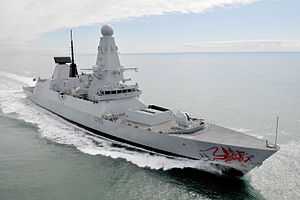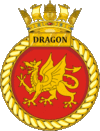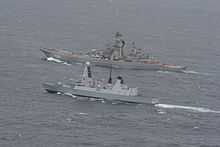HMS Dragon (D35)
 HMS Dragon | |
| Career (UK) | |
|---|---|
| Name: | HMS Dragon |
| Ordered: | December 2000 |
| Builder: | BVT Surface Fleet |
| Yard number: | 1064[1] |
| Laid down: | 19 December 2005 |
| Launched: | 17 November 2008 |
| Sponsored by: | Mrs. Susie Boissier |
| Commissioned: | 20 April 2012 |
| Identification: |
Deck code: DR Pennant number: D35 International callsign: GMIA[2] IMO number: 4907866[3] |
| Motto: | "We yield but to St George" |
| Status: | In active service, as of 2014 |
| Badge: |
 |
| General characteristics | |
| Type: | Guided missile destroyer |
| Displacement: | 8,000 t (7,900 long tons; 8,800 short tons)[4] |
| Length: | 152.4 m (500 ft 0 in) |
| Beam: | 21.2 m (69 ft 7 in) |
| Draught: | 7.4 m (24 ft 3 in) |
| Propulsion: | 2 shafts Integrated electric propulsion (IEP);
|
| Speed: | In excess of 29 kn (54 km/h; 33 mph)[6] |
| Range: | 7,000 nautical miles (13,000 km) at 18 kn (33 km/h) |
| Complement: | 190 |
| Sensors and processing systems: |
|
| Electronic warfare and decoys: |
|
| Armament: | Anti-air missiles: Sea Viper air defence system. Anti-ship missiles: Guns: |
| Aircraft carried: | 1-2× Lynx HMA8, armed with;
or
|
| Aviation facilities: |
|
HMS Dragon is the fourth ship of the Type 45 or Daring-class air-defence destroyers built for the Royal Navy. She was launched in November 2008 and commissioned on 20 April 2012.[11]
Operational history
Dragon 's construction began at the then BAE Systems Naval Ships (later BAE Systems Surface Fleet Solutions) yard at Scotstoun on the River Clyde in December 2005, and by December 2007 the bow section was in place on the Govan slipway for mating with the other modules. Dragon launched from the slipway at Govan on 17 November 2008 at 3:00pm.[12] Her sponsor was Mrs. Susie Boissier, wife of Vice Admiral Paul Boissier, Deputy Commander-in-Chief Fleet and Chief of Staff.[13] She was fitted out at Scotstoun.
HMS Dragon commenced her first set of contractor's sea trials on 5 November 2010.[14]
Recent service

HMS Dragon joined the Royal Navy Surface Fleet on Friday, 20 April 2012.[15] On Friday 27 April she made her maiden visit to Liverpool, staying for three days. She was opened to the public on Saturday 28 April, with visitors able to see the inside of the ship, including the operations room.
In August 2013, it was reported that Dragon was sailing with the USS Nimitz carrier group in the Arabian Sea, acting as the main point ship for aircraft control.[16][17] In August 2013, several Typhoons from No. 6 Squadron RAF were exercising with Dragon and US fighters in the Gulf.[18] It has sailed westwards to the Eastern Mediterranean.[19]
In April 2014, Dragon was deployed to waters north of Scotland, after having sailed from Portsmouth, to track the Russian warship Vice-Admiral Kulakov.[20] She will be part of the Royal Navy's Atlantic Patrol Tasking in the Autumn of 2014.[21]
Characteristics
Advanced air-defence
The Type 45 destroyers are primarily designed for anti-air warfare with the capability to defend against sophisticated targets such as fighter aircraft, drones as well as highly maneuverable sea skimming anti-ship missiles travelling at supersonic speeds.[22] The Royal Navy describes the destroyers' mission as being "to shield the Fleet from air attack".[23] The Type 45 destroyer is equipped with the sophisticated Sea Viper (PAAMS) air-defence system utilizing the SAMPSON active electronically scanned array multi-function radar and the S1850M long-range radar. The PAAMS system is able to track over 2,000 targets and simultaneously control and coordinate multiple missiles in the air at once, allowing a large number of tracks to be intercepted and destroyed at any given time. This makes the PAAMS system particularly difficult to swamp during a saturation attack, even against supersonic targets.[24] The USNWC has suggested that the SAMPSON radar is capable of tracking 1,000 objects the size of a cricket ball travelling at three times the speed of sound (Mach 3), emphasising the system's capabilities against high performance stealth targets.[22] A core component of the PAAMS air-defence system is the Aster missile, composing of the Aster 15 and Aster 30. MBDA describe Aster as a "hit-to-kill" anti-missile missile capable of intercepting all types of high performance air threats at a maximum range of 120 km.[25] The Aster missile is autonomously guided and equipped with an active RF seeker enabling it to cope with "saturated attacks" thanks to a "multiple engagement capability" and a "high rate of fire".[25] Presently the Daring-class destroyers are equipped with a 48-cell A50 Sylver Vertical Launching System allowing for a mix of up-to 48 Aster 15 and 30 missiles.
Weapons, countermeasures, capabilities and sensors
Affiliations
- Cardiff, Wales[26]
- The Royal Thames Yacht Club
- The Worshipful Company of Plaisterers[27]
- The Welsh Livery Guild
- Royal Navy recognised Sea Scout Groups of Barry Scout District
- South Wales District Sea Cadets
Footnotes
| Wikimedia Commons has media related to HMS Dragon (D35). |
- Notes
- References
- ↑ "HMS Dragon at Clydebuilt database". Retrieved 21 June 2009.
- ↑ "Royal Navy Bridge Card, February 201" (PDF). Retrieved 2011-04-18.
- ↑ "World Shipping Register - Ship Index". Retrieved 2009-07-12.
- ↑ "Type 45 Destroyer". Royal Navy. Retrieved 2011-11-06.
- ↑ "HMS Daring". Wärtsilä. Retrieved 2011-08-01.
- ↑ MacDermid, Alan (2007-08-15). "Daring is mean, green and built for speed". The Herald. Retrieved 2007-08-15.
- ↑ "Raytheon Press Release" (PDF). 2006-03-08. Retrieved 2008-01-31.
- ↑ "Jane's Electro-Optic Systems". 2010-10-28. Retrieved 2011-08-21.
- ↑ Royal Navy - HMS Duncan, royalnavy.mod.uk
- ↑ "Air Defence Destroyer (T45)". Royal Navy. Retrieved 2007-11-20.
- ↑ "Dragon shows a flare for action during weapons trials in the Channel". Royal Navy. 2012-03-12. Retrieved 2012-03-15.
- ↑ "HMS Dragon launched". WalesOnline. 2008-11-17. Retrieved 2008-11-17.
- ↑ "Thousands line the Clyde to see HMS Dragon roar for first time". The Herald webpages. Retrieved 2009-02-23.
- ↑ "HMS Dragon off on sea trials in the Clyde". ForArgyll.com. 2010-11-05. Retrieved 2010-11-19.
- ↑ "HMS Dragon Joins the Fleet". Ministry of Defence. Retrieved 2012-04-27.
- ↑ http://www.royalnavy.mod.uk/News-and-Events/Latest-News/2013/August/01/130801-Dragon-prepare-for-new-RN-Carriers
- ↑ http://www.portsmouth.co.uk/news/defence/protecting-the-defenders-on-the-high-seas-1-5448678
- ↑ https://navynews.co.uk/archive/news/item/8625
- ↑ https://navynews.co.uk/archive/news/item/9075
- ↑ "RAF fighter jets scrambled to investigate Russian planes". BBC. Retrieved 2014-04-23.
- ↑ http://www.royalnavy.mod.uk/news-and-latest-activity/news/2014/october/27/141027-hms-dragon-leaves-portsmouth-on-deployment
- ↑ 22.0 22.1 Lombardi, Ben. "The Type 45 Daring-Class Destroyer". https://www.usnwc.edu/''. U.S. Naval War College. Retrieved 20 May 2014.
- ↑ "TYPE 45 DESTROYER". http://www.royalnavy.mod.uk/''. Royal Navy. Retrieved 20 May 2014.
- ↑ Beedall, Richard. "UK PAAMS". http://navy-matters.beedall.com/''. navy-matters. Retrieved 2012.
- ↑ 25.0 25.1 "Aster Anti-Missile Missile" (PDF). http://www.mbda-systems.com/''. MBDA. Retrieved 20 May 2014.
- ↑ "Navy destroyer linked to Cardiff". BBC News. 2007-05-24. Retrieved 2008-03-09.
- ↑ "Worshipful Company of Plaisterers visit". Royal Navy website. Retrieved 2010-12-14.
External links
- Royal Navy HMS Dragon (royalnavy.mod.uk)
| ||||||||||||||
| ||||||||||||||||||||||||||||||||||||||||||||||||||||||||||||||||||||||||||||||||||||||||||